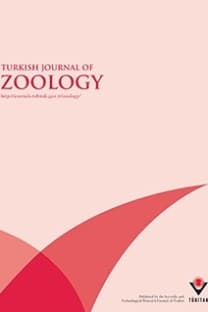Quantitative Estimation of Residues of Neem Compounds (NfC and NC) and Dimilin (IGR) in Treated Callosobruchus analis F. and Contact Media (Filter Paper and Glass) by HPLC
Residues, neem compounds, dimilin (IGR), Callosobruchus analis, HPLC
Quantitative Estimation of Residues of Neem Compounds (NfC and NC) and Dimilin (IGR) in Treated Callosobruchus analis F. and Contact Media (Filter Paper and Glass) by HPLC
Residues, neem compounds, dimilin (IGR), Callosobruchus analis, HPLC,
___
- Butterworth, J.H. and Morgan, E.D. 1968. Isolation of a substance that suppresses feeding in locust. J. Chem. Soc. Chem. Comm., 1: 23- 24.
- Chang, S.C. 1978. Conjugation the major metabolic pathway of 14C- diflubenzuron in the housefly. J. Econ. Entomol. 710: 31-39.
- Chang, S.C. and Stokes, J.B. 1979. Conjugation -Major metabolic pathway of diflubenzuron -14C in the boll - weevil (Coleoptera, Curculionidae). J. Econ. Entomol. 72: 15-19.
- Chang, S.C. and Woods, C.W. 1979. Metabolism of 14C-penfluron in the housefly. J. Econ. Entomol. 72: 482-485.
- Govindachari, T.R., Sandbya, F. and Ganishraj, S.P. 1990. Simple method for the isolation of azadirachtin by preparative High Performance Liquid Chromatography. J. Chromatograph. 513: 389-391.
- Holden, A.V. and Marsden, M. 1969. Single stage clean up animal tissue extract for organochlorine’s residue analysis. J. Chromatograph. 44: 481.
- Khan, M.F. and Ahmed, S.M. 2000. Toxicity of neem leaf extract against Musca domestica as compared to DDVP. Turk. J. Zool. 24: 219- 223.
- Kubo, I. and Kloake, J.A. 1982. Limonoids as insect control agents. Les Colloquesde I RNA (Versaikes, 1983). 7: 116-129.
- Naqvi, S.N.H. 1996. Prospects and development of neem based pesticides in Pakistan. Proc. Pakistan Clongr. Zool. 16: 325-338.
- Nizam, S. 1993. Effect of allelochemicals against 3rd instar larvae of Musca domestica L. (Malir strain). Ph.D. thesis, Department of Zoology, University of Karachi, Karachi, Pakistan.
- Rembold, H., Sharma, G.K., Czoppelt, Ch. and Schmutterer, H. 1980. Evidence of growth disruption in insects without feeding inhibition by neem seed fractions. Z. Pflkrankh. Pflschutz. 87: 291-297.
- Schmutterer, H. 1987. Fecundity-reducing and sterilizing effects of neem seed kernels extracts in Colorado potato beetle; Leptinotarsa decemlineata. Proc. 3rd Int. Neem Conf. (Nairobi, 1986), pp.351-360.
- Sieber, K.P. and Rembold, H. 1983. The effects of azadirachtin on the endocrine control of moulting in Locusta migratoria. J. Insect Physiol. 29: 523-527.
- Spates, G.E. and Wright, J.E. 1980. Residues of Diflubenzuron applied topically to adult stable flies (Diptera, Muscidae). J. Econ. Entomol. 73: 595-598.
- ISSN: 1300-0179
- Yayın Aralığı: 6
- Yayıncı: TÜBİTAK
Farzana YOUSUF, Quddusi B. KAZMI, Farah ALI
Distribution of the Gekkonidae species in Southeast Anatolia, Turkey, and new localities
İsmail Hakkı UĞURTAŞ, Murat SEVİNÇ, Hikmet S. YILDIRIMHAN
Türkiye’nin Antalya Havzası’ndan Yeni Bir Balık Türü, Pseudophoxinus alii
Güneydoğu Anadolu’da Yaşayan Gekkonidae Familyasına Ait Türlerin Dağılışı ve Yeni Lokaliteler
İsmail Hakkı UĞURTAŞ, Hikmet S. YILDIRIMHAN, Murat SEVİNÇ
Orhan ERDOĞAN, Mustafa TÜRKMEN, Ayhan YILDIRIM, Halil İbrahim HALİLOĞLU
Rahila TABASSUM, S. N. H. NAQVI, M. Farhanullah KHAN
Free-living Ciliates of the Anzali Wetland of the Caspian Sea
